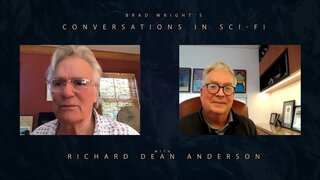Create a free profile to get unlimited access to exclusive videos, sweepstakes, and more!
How the Stargate Itself Changed Between the Movie and SG-1
Stargate's title prop had to evolve from the big screen to the small.
It took three years for Stargate to shift from its big-screen debut in 1994 to the launch of flagship SYFY original series Stargate SG-1, the first of three TV series that would cement the franchise's status as a sci-fi staple and carry it forward into the new millennium with hours of adventures for both familiar and brand-new characters. The transition didn't take that long, but it was long enough that the TV production had to build an entirely new Stargate, with a few stylistic changes along the way.
In a new interview with Dial the Gate, Stargate SG-1 production designer Richard Hudolin, who worked on the show for its first five seasons, laid out the journey to adapting the physical Stargate for the TV series. It began with a trip to what he described as a "ranch" outside Los Angeles, where the original Stargate prop from the feature film had been reduced to "scrap."
“It was in pieces," Hudolin explained. "It was scrap at that point. And if you look at the detail on it you say, ‘I could pull a mold off of that,’ or ‘At least I’ve got something I can draw from or pull an image from it.’"
RELATED: One of Stargate SG-1's Greatest Episodes Was Originally Supposed to Be a Movie
There was enough to get started on the new prop, so Hudolin had his team hauled two "tractor trailers" worth of Stargate scrap up to Vancouver, where SG-1 was in pre-production. There, using the bits of the original Gate as reference, he started working on the TV version of the prop, and as longtime Stargate fans know, he made a few tweaks.
How the Stargate Changed
The biggest visual difference, at least for viewers, comes from the chevrons spaced out along the Gate's outer ring. In the film, they're the same color as the rest of the structure, but in the show they're augmented with lighted red crystals, which Hudolin explained simply looked better onscreen. To further add to the visual dynamism, he also altered the constellation glyphs placed on the Gate, making them raised letters instead of stamped, recessed ones, so they would cast shadows and, once again, look more interesting for the audience.
But for Hudolin, his proudest achievement was the inner ring of the Gate. Both versions of the prop feature a spinning inner ring, but in the film version, much of the spinning was done manually through the aid of carefully hidden crew members. For SG-1, the crew needed a Gate that would spin at will, episode after episode, without the need to disguise what was really working things. So, Hudolin had a massive motor custom made for the prop, and according to him, it never broke down.
"Even after I left it worked perfectly,” he said. “It just worked.”






























